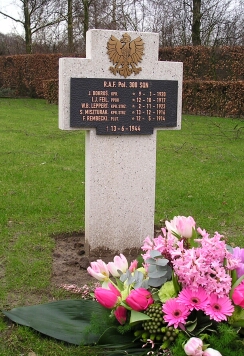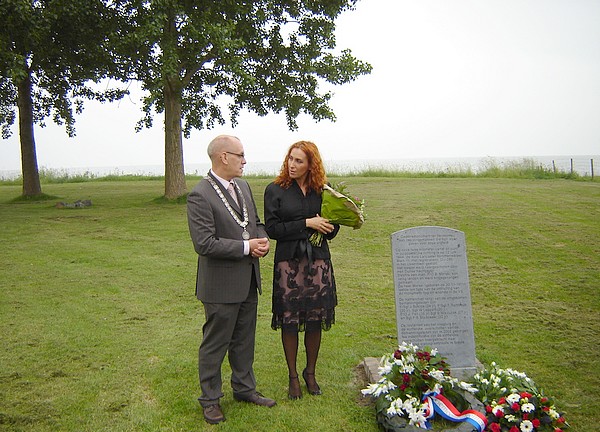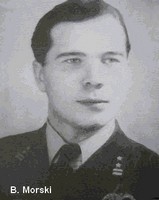SOLEMN BURIAL OF POLISH AIRMEN
A special ceremony took place on the Polish Military Field of Honour at Breda, the Netherlands, on Saterdayafternoon the 25th of October 2003. For, in fact, it seldom occurs, that a last tribute of respect is paid to airmen, who died in action almost 60 years ago, in the Second World War. On that day the mortal remains of the 5 crewmembers of the bombing-plane Lancaster DV-286 of the Polish 300 Squadron, a unit of the British Royal Air Force, who were killed in action, have been buried.
In 1998 a wreck of a plane was found, by accident, by Volendam fishermen, not
far from the IJsselmeercoast, near the village of Wijdenes, the Netherlands.
After much tracework, in a.o. the RAF archives, it proved to be one of the
Lancasters, missed on June the 13th.1944. It was lying about 3 metres deep,
covered with a very thick layer of mud. During the night of the 12th/13th of June 1944 the RAF executed a tremendous bombardment above the Ruhrarea,
Germany. Their main aim was the town of Gelsenkirchen and a synthetic
oil-factory, situated there. 286 Lancasters participated in this action,
among them 3 of the Polish 300 Squadron. None of these 3 aircrafts returned
to its basis. The losses of this "black night" were dramatic for
the Poles: in one night the squadron lost 20 crewmembers and 3 of its 9
Lancasters.
One of these bombers, after finishing its mission, was shot down by a German
nightfighter above Dutch territory, on its way back to the British base
Faldingworth and crashed into the IJsselmeer. Two crewmembers: bomb aimer
Bogusław Morski and flight engineer Feliks Bladowski succeeded in jumping out of the plane in time and landed into the IJsselmeer. A good three hours later Morski was taken out of the water by two fishermen. Some days later Bladowski's dead body was washed ashore near Wijdenes. Morski was the only survivor of the crash. He was taken to the camp for prisoners of war Stalag Luft 3 at Żagan, Poland, where he stayed till the end of the war. After the war Morski moved to the United States, where he has been living up to this day.
The Polish war-veteran was deeply moved after learning the news from the
Netherlands about the tracing of the wreck, in which, to all probability,
were the mortal remains of his companions. Morski was in the supposition that
their Lancaster, provided with the BH-C code had crashed into the North Sea,
so that the chance of finding back the wreck was practically nil. Although he
described in 1996 the story of his last mission on June the 12th 1944 in the
Polish magazine "Nowy Dziennik", published in New York, the last
minutes of this flight proved to have had a different course from what he had
always thought.
The article of B. Morski:
12-13 Juni 1944, No. 300 (Polish) Squadron DV 286, code BH-C
Our seven-man Lancaster crew was rather unusual. The pilot, Franek Rembecki
and the flight engineer, Franek Bladowski, were like Siamese twins,
inseparable. They knew each other before the war when they served in the same
squadron. They made up their minds to get into the same crew after training
in Britain and succeeded.
Staszek Miszturak, our tail gunner, came from the southern borders of Poland,
he was always cheerful, given to humming a tune under his breath.
Władek Leppert, midup gunner, the youngest of us, belonged to a
well-known family of industrialists, came straight from a high school in
Scotland.
Janek Bokroś, our wireless operator, was an unusual character, a
Slovakian. Before the war he had emigrated to Brazil: he had happy memories
of skiing in Poland and preferred the Polish snow on N. mountain slopes to
the Slovakian side.
Our navigator, Jurek Feil, ought to have a separate chapter; he was a
reservist cadet of Jewish origin but had left Poland before the war to read
Maths at Columbia University, New York. He flew to Britain to join our Air
Force as soon as France fell. He and I always kept in contact: we spent our
leaves together and were determined to fly in the same crew and achieved this
in April 1944.
After numerous practice trips together, our team of seven became great
friends. All on Christian name terms; Jurek and I were officers and the other
5 were Sgts. but no one felt any superiority about their particular job or
rank. We knew we could rely on each other. We were assigned to No. 300 Sqdn.
at Faldingworth in May 1944. We were much impressed by our first operations,
bombing railway junctions in France and even more so by the attack on German
strongpoints in Normandy on 6 June, our way home we had a great view of the
whole Invasion fleet, hundreds of vessels crowded with men and equipment. I
remember thinking, here we are, safe on our way home, and in an hour's time
these chaps will be storming German positions in Normandy and perhaps bearing
terrible losses.
The date reached 12 June and our next target was Gelsenkirchen, in the Ruhr.
We set off in 3 Lancasters at 8 in the evening, all intent on the job. We met
AA fire and searchlights tried to catch us but we found the target, though it
was being strongly defended and we flew through a forest of searchlights. We
felt the a/c lift as we released our Cookie and the incendiaries. Just as I
gave Jurek the pinpoint on the way home as we crossed the Dutch coastline and
there was a tremendous crash, the a/c shuddered, a strong smell of cordite,
intercom went U.S. and Franek Bladowski, the engineer, dashed to my position
and shouted "We're jumping". I put on my parachute and jumped: as l
glided down I saw our machine diving to the sea in flames.
So far the story of B. Morski.
The unexpected, good news made Morski decide to do everything in his power to
have this wreck salved and to organize an honourable burial for his perished
colleagues. Last spring it happened, at last. After many preparations, which
took a lot of time, such as making the necessary contacts with organizations
of Polish old-combattants and the relatives of the killed soldiers as well
as with the "Oorlogsgravenstichting" = the Dutch War Graves
Commission, parts of the wreck could be taken out of the water. The Dutch
Royal Airforce, the Royal Navy and the municipality of Lelystad have also
done everything in their power to make it possible.

The official burialceremony, however, was postponed till the end of October,
that is the time the town of Breda commemorates its liberation by the 1st
Polish Armoured Division under the command of general Stanisław Maczek
on the 29th. of October 1944.
On October 25, 2003, the eve of this commemoration, the mortal remains of the
five, on the 13th. of June, killed crewmembers of the Lancaster DV-286 have
been solemnly buried on the Polish Military Field of Honour at Breda.
The sixth killed crewmember Felix Bladowski was since 1962 buried on this
Field of Honour in 1962.
The fervent wish of the only survivor, lieutenant-colonel Bogusław
Morski, now 86 years old, has been fulfilled now. He flew over from the
United States to Holland for this special ceremony in which he and with him
groups of Polish war-veterans from different countries and relatives of the
killed soldiers took leave for the last time of their comrades-in-arms in an
honourable way. The burialceremony was also attended by the Head of the
Office of Polish old-combattants the minister Turski, the Polish ambassador
in Holland mr. J. Michalowski, the burgomaster of Lelystad, mrs. C. Leeuwe and of Breda, mr. C. Rutten. Breda's former bishop H. Ernst and 3 Polish
clergymen celebrated a Mass in a nearby church. Some 400 people were present
at this moving event.
The 25th of October 2003 is a memorable day.

12th of June 2007
On the 12th of June 2007, during a minute's silence, the water in the Markermeer seemed
as yet to be called as a witness after 63 years.
Witness of the Lancaster bomber, which crashed in front of the coast of Wijdenes on the
12th of June 1944.
Near the small port of Wijdenes the stone, showed below, was unveiled with the names of
5 perished Polish members of the crew.
The 6th member of the crew, bomb-aimer Bogusław Morski, survived the crash and is living
in the U.S.A. The trip to Wijdenes, however, proved to be too heavy for him, seeing that
he is 86 years old at the moment.
On the other hand, Evrydyka Cherka, granddaughter of the perished member of the crew,
Bladowski, was present there. Together with the burgomaster of Drechterland, mr. Rob van der Riet, she laid a wreath on the monument.

The text on the memorial stone says:
Memorial-monument in remembrance of six young men who gave their lives for our freedom.
At about two kilometers from this point in South-Eastern direction the Avro Lancaster bomber
Mark III with the registration-number DV-286 plunged into the IJsselmeer on the 12th of June 1944.
The machine was shot down by a German night-fighter.
One man only, P/O B. Morski, was able to land safely - he was taken prisoner-of-war.
Mr. Morski (born on the 30th of November 1911) was still alive when this monument was unveiled.
He lived in the United states.
The names of the killed members of the crew are:
F/Sgt J. Bokros (24), F/Sgt F. Rembicki (20), Sgt W. Leppert (20), P/O J. Feil (25),
Sgt S. Miszturak (26) and Sgt F.S. Bladowski (32)
The remnants of the plane have been salved and the mortal remains of the members of the crew recovered
in 2003.
After identification the mortal remains have been removed to the Polish burialplace of honnour at Breda.

|




